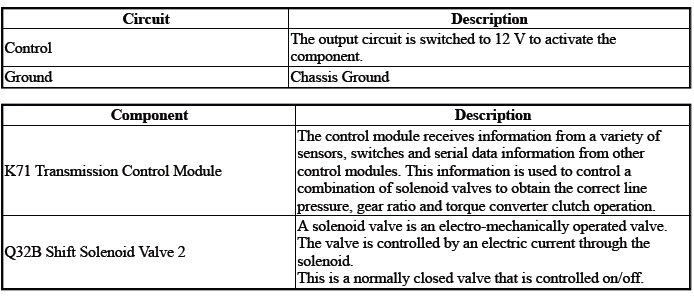Buick Regal: DTC P0976 or P0977
Diagnostic Instructions
- Perform the Diagnostic System Check prior to using this diagnostic procedure: Refer to Diagnostic System Check - Vehicle
- Review the description of Strategy Based Diagnosis: Refer to Strategy Based Diagnosis
- An overview of each diagnostic category can be found here: Refer to Diagnostic Procedure Instructions
DTC Descriptor
DTC P0976
Shift Solenoid Valve 2 Control Circuit Low Voltage
DTC P0977
Shift Solenoid Valve 2 Control Circuit High Voltage
Diagnostic Fault Information

Typical Scan Tool Data
Shift Solenoid Valve 2 Control Circuit High Voltage Test Status

Shift Solenoid Valve 2 Control Circuit Low Voltage Test Status

Shift Solenoid Valve 2 Control Circuit Open Test Status

Circuit/System Description

Depending on the state of the linear solenoids, the position of the Q32B will cause either a gear shift or 1st gear engine braking.
Conditions for Running the DTC
Ignition Voltage=9 to 32 V
Frequency the DTC runs=Continuously - After the running conditions are met - For 2 s
Conditions for Setting the DTC
P0976
Shift Solenoid Valve 2 Control Circuit=Off & Shift Solenoid Valve 2 Command=On - For greater than 5 s
P0977
Shift Solenoid Valve 2 Control Circuit=On & Shift Solenoid Valve 2 Command=Off - For greater than 5 s
Actions Taken When the DTC Sets
DTCs listed in the DTC Descriptor Category=Type B DTC
- Learning=Disabled
- Fail-Safe Mode=Active
- Transmission gear allowed=3rd Gear - After a stop
Conditions for Clearing the DTC
DTCs listed in the DTC Descriptor Category=Type B DTC
Reference Information
Schematic: Reference
Refer to Automatic Transmission Controls Wiring Schematics.
Connector End View: Reference
Refer to Component Connector End View Index.
Component View: Reference
Refer to Disassembled Views.
Description and Operation
Refer to Transmission General Description.
Electrical Information: Reference
- Refer to Circuit Testing
- Refer to Connector Repairs
- Refer to Testing for Intermittent Conditions and Poor Connections
- Refer to Wiring Repairs
DTC Type: Reference
Refer to Powertrain Diagnostic Trouble Code (DTC) Type Definitions.
Scan Tool: Reference
Refer to Control Module: References.
Circuit/System Verification
1. Engine - Running
2. Perform the scan tool control function:Pressure Control Solenoid Valve 2 - Increase & Decrease
Verify the scan tool parameter:
- Shift Solenoid Valve 2 Control Circuit High Voltage Test Status=Not Run or OK
- Shift Solenoid Valve 2 Control Circuit Low Voltage Test Status=Not Run or OK
- Shift Solenoid Valve 2 Control Circuit Open Test Status=Not Run or OK
- If not the specified state
Refer to Circuit/System Testing
- Go to next step: If the specified state
3. Perform the scan tool control function:Pressure Control Solenoid Valve 2 - Increase & Decrease Verify the component produces a clicking sound:Q32B Shift Solenoid Valve 2=On and Off
- If the component does not produce a sound
Refer to Circuit/System Testing
- Go to next step: If the component produces a sound
4. Operate the vehicle within the Conditions for Running the DTC. You may also operate the vehicle within the conditions that you observed from the Freeze Frame/Failure Records data.
Verify the DTC does not set.
- If the DTC sets
Refer to Circuit/System Testing
- Go to next step: If the DTC is not set
5. All OK.
Circuit/System Testing
NOTE: It may take up to 2 min for all vehicle systems to power down before an accurate ground or low reference circuit continuity test can be performed.
1. Ignition/Vehicle & All vehicle systems - Off.
2. Remove the component:K71 Transmission Control Module.
NOTE: The component's temperature should be 19 to 21ºC (66 to 70ºF) while testing.
3. Test for 11 to 15 ohms between the test points:Control circuit terminal 28 & Transmission Case
- If not between 11 and 15 ohms
- Remove the component:Control Valve Body Cover
- Disconnect the electrical connector:Q32B Shift Solenoid Valve 2
- Test for less than 2 ohms between the test points:Control circuit terminal 28@Control module harness & Control circuit terminal 1@Component harness
- If greater than 2 ohms - Replace the component:Automatic Transmission Wiring Harness
- If less than 2 ohms - Replace the component:Control Valve Body
- Go to next step: If between 11 and 15 ohms
4. Replace the component:K71 Transmission Control Module
Component Testing
1. Ignition/Vehicle - Off
2. Disconnect the electrical connector:Q32B Shift Solenoid Valve 2
NOTE: The component's temperature should be 19 to 21ºC (66 to 70ºF) while testing.
3. Test for 11 to 15 ohms between the test points:Control terminal 1 & Transmission Case
- If not between 11 and 15 ohms
Replace the component:Control Valve Body
- Go to next step: If between 11 and 15 ohms
4. All OK.
Repair Instructions
Perform the Diagnostic Repair Verification after completing the repair: Refer to Diagnostic Repair Verification
- Refer to Control Valve Body Replacement
- Refer to Wiring Harness Wire Replacement
- For control module replacement, programming, and setup: Refer to Control Module: References

